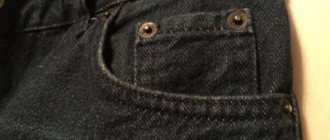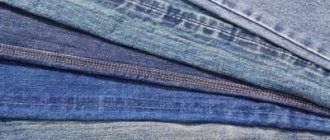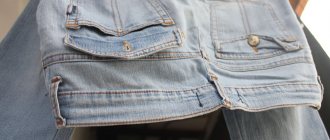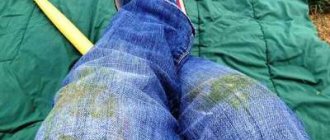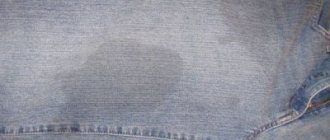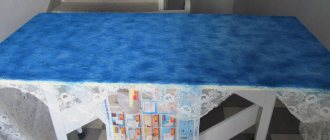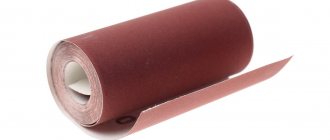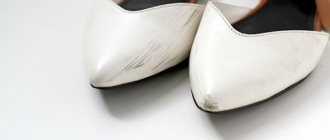Even if jeans generally fit perfectly, if they are too big in the waist, they will be uncomfortable to wear. It's no secret that denim pants are made according to clearly established standards. This means that even if your figure deviates slightly from the generally accepted parameters, choosing jeans will be problematic. But the problem is easy to solve if there is a sewing machine in the house and you have an understanding of how to use it. However, even in the absence of a sewing mechanism, you can reduce your waist manually using simple tools such as a needle and thread.
How much can you reduce
Even the best quality jeans lose their shape and stretch as they wear them. This is absolutely no reason to rush to turn them into lounge pants. Any denim item in your wardrobe can be made smaller by a size or even two without any problems. All that is required for this is to prepare the necessary tools and stock up on time and patience.
You can reduce your jeans size yourself
How to sew in at the waist
The process of sewing jeans on your own is not particularly difficult. This can be done in different ways: in the waistband along the back seam, using darts, using a zipper at the back or using an elastic band. To work in all of the above cases, you will need the following materials and tools:
- thread;
- needle;
- scissors;
- pattern;
- ruler;
- chalk;
- pins;
- sewing machine;
- overlock;
- elastic/zipper.
You can sew in a couple of sizes of jeans along the back seam
Necessary materials
For work you may need:
- tailor's pins (with a head or an eye);
- pencil, soap or chalk;
- centimeter;
- long ruler;
- sewing needles;
- threads to match the color of jeans and suture threads;
- iron or steamer;
- sewing machine;
- scissors;
- thick elastic band.
If everything is available, get to work.
Big jeans have no place in the closet - sew them in and keep wearing them
How to sew in a waistband along the back seam
The correct way to sew jeans in at the waist along the back seam is something like this:
- Try on jeans.
- Pin (with someone's help) along the middle seam, removing excess fabric that will need to be sewn.
- Use chalk to mark the places where the pins are attached.
- Carefully rip off the belt and make a cut in the center.
- Open the middle seam of the jeans.
- Using the control marks drawn earlier with chalk from the inside, draw a new middle seam using a pattern and a ruler.
- Add a seam allowance of approximately 1.5 cm.
- Cut off excess fabric and pin everything with pins.
- Baste the new middle seam.
- Try on jeans.
- If everything is fine, sew the seams using a machine.
- Sew the edges using an overlocker.
- Iron the seam carefully.
- On the front side, if necessary, add finishing stitches using contrasting threads for sewing jeans.
- Trim excess from waistband, leaving seam allowances.
- Sew the parts together and sew in the belt, not forgetting to sew the belt loop.
You might be interested in: Correctly threading the bobbin, hook and bobbin thread in a sewing machine
Sewing along the back seam should be done as carefully as possible.
This is one of the answers to the question of how to sew in jeans.
Despite the fact that suturing is done from the back, the pants or shorts will also fit tighter on the sides.
Suturing locally
If your jeans look great on you but are a little big in the waistband, sewing them in along the back seam and waist can help remedy the situation.
If your favorite model has become a little loose, then it is worth stitching only along the side seams. To create a tapered hem, you should sew the jeans along the inside seams.
At the waist
Many girls have wide hips and small waists, so any pair of jeans will be loose in the waist. To solve this problem, jeans should be sewn in one of two ways.
The first method is the simplest:
- First you need to make several darts along the belt line.
- Next, you need to carefully rip off a few centimeters of the belt.
- Carefully stitch all darts.
- Cut off the extra centimeters on the belt, and then sew it back.
- You must be extremely careful when creating a dart in the buttock area, as very long seams will pull them up.
The second method is more complex, but of high quality:
- First you need to undo the belt loop, which is located in the back center. In some models, it is necessary to remove three belt loops at once. If the branded label is located nearby, it should also be removed.
- Carefully open the waistband, but only ten centimeters to the left and right of the middle seam of the product.
- Then you need to pay attention to the crotch seam and space it out by eight or nine centimeters.
- Remaining threads should be removed and all seams should be ironed thoroughly.
- The middle seam must be secured on the front side with pins to avoid possible displacement. Next, transfer the fastening with pins to the wrong side and steam with an iron.
- Fold the trouser legs together and draw a line at a slight angle at a distance of about two centimeters.
- The drawn line must be stitched and the edges of the fabric overcast.
- Next, turn the jeans right side out and make two lines in the center.
- Go to the wrong side again to sew up the crotch seam, and finish the double stitch on the front side.
- The belt must be applied to the new waist size and the extra centimeters must be trimmed, but remember the allowances.
- Next, the product must be folded in half, right sides inward, stitched and unfolded before ironing.
- Fasten the belt and the main part of the product with pins and sew the belt loop back.
In the hips
To reduce the size of jeans at the hips, you should sew them in at the side seams.
To calculate the distance that needs to be removed, you can use one of the following methods:
- Turn the jeans inside out and put them on. Use pins to mark the new seam.
- Take the trousers that suit your figure, attach the ones you want to sew in and draw a line.
The process of reducing the volume of pants in the hips occurs in several stages:
- First you need to undo the belt.
- Next, rip the legs apart at the sides and stitch them along the new seams.
- Cut off excess material and sew down the sides.
- Sew the belt into place.
If the jeans are spacious in the hips and waist, then the belt should not be steamed. The trouser legs must be completely ripped open and carefully sewn to the new dimensions.
For thin denim jeans, you can make darts on the sides, then the model will fit better.
1
Sewing equipment
Sometimes a new item, when trying on at home, turns out to be the wrong size or does not fit perfectly. This happens because factories sew products according to certain measurements, which not every figure corresponds to. Therefore, a new item may have fit defects and may not look beautiful enough. This does not mean that you bought defective clothes, just that your parameters do not correspond to the standard ones.
If the item doesn’t fit or you suddenly lost weight, but don’t want to part with your favorite jeans, you can “adjust” them to your figure yourself, even without special skills. To sew jeans at home, you will need:
- sewing machine or set of needles for hand sewing;
- measuring tape and ruler;
- seam ripper (can be replaced with a stationery knife or nail scissors);
- scissors;
- threads to match the fabric and finishing stitching;
- chalk or soap;
- tailor's pins;
- iron.
How to starch a shirt at home - step-by-step instructions
How to reduce with darts
Darts will help you change the size of denim trousers to a smaller one. This is the easiest way to adjust your pants to your figure so that both the hip and waist fit like a glove.
Properly made darts can work wonders
The step-by-step principle of sewing involves performing the following steps in a clear sequence:
- Give an initial fitting to understand the actual size of the trousers and how much they will need to be sewn.
- Using pins (with someone's help), mark the places where the darts will be least noticeable. As a rule, the most inconspicuous area is in the buttocks area.
- Measure how many centimeters should be removed.
- Open the belt in the place where the darts will be, making small cuts.
- Baste darts.
- Try on a wardrobe item.
- Make a neat seam using a machine or by hand.
- Trim off excess fabric from the waistband.
- Finish the edges of the fabric.
- Sew the sections together.
Important! The smaller the grooves, the better. Otherwise, over time, a not very aesthetic fold may form in the buttock area.
Neat darts do not spoil the appearance of the product
It would be an exaggeration to say that even a child can cope with the work described, but if you have minimal sewing experience, performing the described manipulations will not be difficult.
How to sew using a zipper at the back
Another interesting way to reduce the waist of jeans is by using a zipper. This is not the fastest process and requires some experience.
In this case, the following tools and materials will come to the rescue:
- ripper or blade;
- threads;
- needle;
- zipper of suitable length;
- chalk;
- pins;
- sewing machine.
You can make jeans smaller by sewing a zipper in the back.
The sewing itself is done as follows:
- Try on jeans and measure how many centimeters need to be removed.
- Carefully secure the fold with pins.
- Take off the jeans and draw lines along which the zipper will then be sewn.
- Carefully open the back seam.
- Cut the belt.
- Tuck the edges of the back.
- Sew with contrasting thread.
- Attach and sew in the zipper.
- Try on the product.
- Remove the zipper and stitch the folded edges, simultaneously grabbing parts of the belt.
- Baste the zipper again and sew it on.
Jeans with a zipper at the back look very stylish
How to make jeans smaller with an elastic band
If the belt at the waist is not too large, you can solve the problem with the help of an ordinary wide elastic band. To sew it in, you need to do the following:
- Undercut the waistband of the jeans from the wrong side at the back.
- Cut off the elastic.
- Attach the elastic band to the waistband using pins.
- Try it on and, if necessary, reduce the length of the elastic.
- Sew it to the belt.
- Sew on the belt itself.
You might be interested in: Making patterns and sewing a hat with a brim yourself
It doesn't take much experience to sew in elastic.
As a result of these actions, only a small ruffle will be visible on the back of the jeans, and the trousers themselves will fit perfectly at the waist.
Stitching in the hips
Another home-made way to sew in jeans at the waist without resorting to the services of professionals is to reduce them at the sides.
Before starting work, the product must be thoroughly washed and ironed, regardless of whether the item of clothing is being remade, old or new.
The algorithm of actions should be approximately as follows:
When sewing jeans, you must try them on inside out.
- Turn your pants inside out.
- Try them on like this.
- Use pins to mark the places where the side of the product should be reduced in volume.
- Take off your jeans and carefully lay them out on any horizontal surface.
- Using chalk, draw a line along the pins where the seam will run.
- Hand sew the jeans along the marked lines.
- Turn the pants right side out and try them on. An important condition: you must try to sit down.
- If no discomfort is felt, you can continue working.
- Open the waistband at the bottom and the side waistband.
- Trim off excess fabric, leaving 1.5 cm for seam allowance.
- Sew jeans.
- Finish the edge (overlock or zigzag).
- Use a steamer to smooth the side edges.
- Finish along the side seam using contrasting threads.
- Remove extra centimeters from the waistband.
- Sew the previously opened area.
- Iron the product completely.
- Carry out similar actions on the other side.
- Finally try on the product.
Useful tips
When using life hacks that will help you sew jeans into a waistband, it is important to take into account the rules for high-quality processing of the product:
- Jeans that need to be sewn in at the waist should go through at least one wash, which will help avoid shrinkage after alterations.
- Trying needs to be done several times. This will allow you to more accurately achieve the desired size.
- To sew up your favorite wardrobe item, you can use a template in the form of old, narrower pants.
- You should avoid completely ripping apart the legs, since it is almost impossible to sew the crotch area yourself at home.
- The threads must be strong so that the tapered jeans do not come apart at the most inopportune moment.
- The edges of the cuts must be carefully processed using an overlocker or by hand overcasting.
How to reduce by washing
In the absence of sewing machines, overlockers and other equipment, you can try to reduce the size of your jeans using an old proven tool. Home and home conditions are also quite suitable for its use. We're talking about laundry.
Properly hand washed jeans fit perfectly.
If old jeans were durable and did not stretch when worn, the use of new technologies has led to the fact that the rough fabric has become more elastic. And since each leg bends at the knee when walking, and when bending over, the waist part of the product is extended, there was a need to find a way to return jeans to their original appearance.
Many people do not see the need and do not have the desire to take out sewing tools and sew up excess fabric using a blind stitch. There is an easy-to-follow life hack that allows you to quickly and effectively reduce jeans by at least a size. We're talking about laundry. Washing can be done either by hand or by machine.
You might be interested in: Creating a pattern and sewing a hoodie (hoodie)
Handwash
Hand washing is a great way to reduce a jeans size. To do this, they should arrange a contrast shower, switching from hot water to cold water and back while rinsing. The fabric will shrink even more by soaking the product for a couple of hours, first in cold and then in hot water. When the washing process is completed, the trousers should be squeezed very hard and for a long time until the hand gets tired. To dry the product, it is better to place it in the dryer and set it to hot drying.
When washing jeans to shrink, do not pay attention to the manufacturer's recommendations.
This is interesting! If you don’t hang the jeans after drying, but carefully lay them out on natural fabric, they will shrink a little.
Machine washable
Machine washing in solving the problem of reducing the size of jeans will be no less effective. As in the previous case, shrinkage occurs due to the use of hot water. When exposed to heat, the fibers shrink and the product becomes slightly smaller. It is recommended to machine wash the product as follows:
- Throw the pants into the drum of the washing machine.
- Set the washing machine to the highest temperature setting and high spin speed.
- Add any detergent and rinse aid.
- After washing, leave the product in the dryer, also at maximum temperature.
- Repeat the procedure until the desired result is obtained.
At a temperature of 90 degrees in the car, jeans are guaranteed to fit.
Important! If you iron your jeans after machine washing, this will shrink the fabric a little more.
Reducing pants without sewing
If you need to make your jeans a size smaller, you don't have to alter them. You can use the following method:
- Wash the product at high temperature. Place the trousers in the washing machine and turn on the wash cycle at 95 degrees. Afterwards, hand-wringe the jeans and dry them. This is necessary to prevent cold water from entering the item.
- Dry your washed pants on a radiator or using a steam dryer.
Remember that quick drying always shrinks things, but don't overdo it, because it may be difficult to put them on afterwards.
It is also advised to resort to “shock therapy”. Place ice water and boiling water in separate containers. Dip the trousers alternately into one or another bowl several times, holding for 5-7 minutes in each. Then squeeze and dry.
Such methods will not give long-term results. After a few repeated wears, the jeans will stretch again. Therefore, if the designer’s goal is to reduce the item for a long time, you need to master sewing skills and get to work.
Features of work
Working with denim requires knowing some secrets and nuances.
You need to know how to work with denim
We are talking primarily about the following points:
- Before cutting, the jeans product must be washed. Washing will soften the fabric and make it much easier to work with.
- Scissors should only be used that are well sharpened. And you need to be prepared for the fact that after cutting they will most likely become dull.
- You need to install special thick needles in your sewing machine that will not become dull or break.
- It is recommended to use heavy-duty threads. If you can’t find special threads for denim, you can replace them with polyester or durable cotton ones.
- On particularly thick areas, do not sew using the machine pedal. It will be easier and safer to stitch such thickened areas by slowly turning the wheel by hand.
- Seam allowances must be ironed.
- It will be easier to sew jeans with a stitch with an increased length.
Properly fitted jeans are comfortable to wear.
Sewing jeans, although not the most difficult process, does require certain skills. If someone has minimal or no sewing experience, it is strongly recommended not to experiment. It would be much more prudent to seek help from specialists who will quickly and efficiently adjust any item of denim clothing to the desired size.
Recommendations for sewing jeans
If you don’t want to go to a tailor, you can easily alter your jeans yourself. Useful lifehacks will help you do everything right:
- Be sure to iron the seams as you work. Do the same after completion to return the trousers to their original appearance and smooth out any protruding seams.
- Work with pants that are clean but already worn. This way you will understand how much jeans can stretch. But keep in mind that the product will shrink after washing.
- Don't neglect finishing the edges. This will prevent the fabric from fraying and extend the life of the item.
- Don't do the job hastily. Each sub-item must be included (measurements, basting, etc.). This will help avoid damage to the product.
- Don't strip off excess. Not everyone can fully sew an item.
- Select threads carefully based on color and strength. For denim, it is advisable to buy special ones - they are reliable.
- Be sure to remove old threads from the fabric, otherwise they will ruin the look.
- If you don’t want to waste time on long fittings, then use the method of using a second product that fits your figure perfectly. If you have such jeans in stock, then you just need to remove the pattern from it and transfer it to a wide model. Another option is to attach the item to the pants being altered and make notes.
